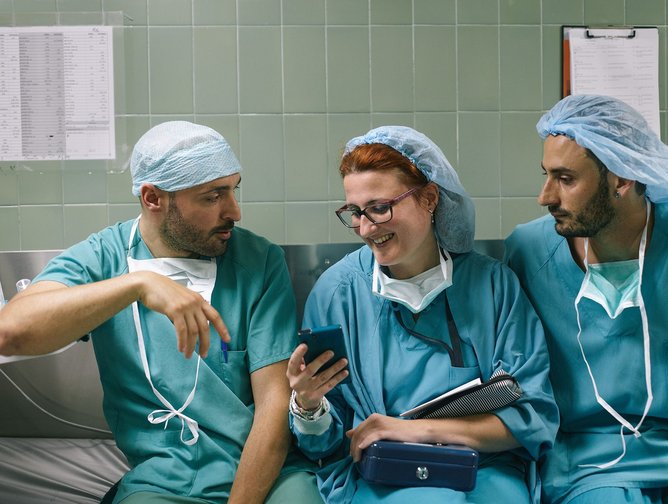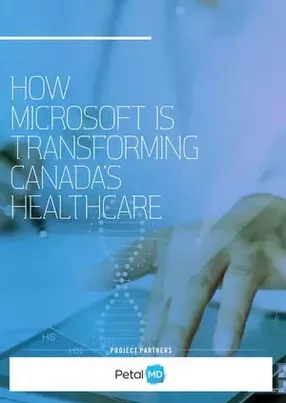It is no exaggeration to say that Microsoft has changed the world, as it has transformed nearly every part of people's working and home lives - after all, around a fifth of the world's population uses Microsoft products on a daily basis. Next, the IT giant is set to revolutionize healthcare.
The healthcare system faces some tough challenges. Wait times are lengthy, whether in the emergency room, referral to a specialist, or making appointments to see a doctor, and processes can generally be slow-moving.
Meanwhile healthcare IT has traditionally been focused on hospital-based Electronic Health Records (EHR), but part of Microsoft's digital vision is to move beyond this and onto more efficient processes. Peter Jones, Microsoft's Industry Lead in Healthcare for Canada, explains:
"Traditionally we've spent a lot of money and resources on digitizing healthcare records. We are now focused more on systems of insight that will enable us to access data and make better decisions on patient care and the operations in the hospital."
As well as shifting from systems of record to systems of insight, Jones explains they are moving towards systems of engagement, making it possible for patients to interact with healthcare providers in new ways. Patient engagement is one of the four pillars of Microsoft's model to transform the country's healthcare system, alongside empowering care teams, optimizing operations and transforming the continuum for better patient care.
Patient engagement
Now that it's possible to book everything from a taxi to a grocery shop via a touchscreen, it makes sense for patients to want healthcare to be just as accessible.
New technology that enables care teams to monitor patients remotely is of huge benefit to people with chronic conditions, as it cuts down on wait times for appointments, and means those with limited mobility, such as the elderly, don't need assistance with travelling to appointments.
The eVisit, developed in conjunction with telemedicine specialists Novari Health, makes it possible for patients to schedule virtual consultations with doctors. It's as simple as clicking on a meeting request in an email to carry out a virtual appointment from the comfort of the patients' home. "You can get access to a member of your care team including doctors and nurses," Jones explains.
Empowering care teams
here are better ways to help clinicians communicate, collaborate, team and learn. The Office 365 platform allows members of the care team to communicate and collaborate on better patient care.
"If you look at how we're moving beyond EHR, one of the biggest challenges has been communication amongst care teams" Jones says. "Many care team members are overworked and struggling to produce but putting the communication and collaboration tools in place has allowed them to become more efficient and more effective in their job." A good example of this is a solution from a partner called PetalMD.
It offers a cloud-based solution to help physicians create, manage and collaborate on scheduling shifts with co-workers. It helps saves time, allows remote access to schedules, provide tasks and transfers all in one platform on Azure, dramatically reducing errors and prevent outdated information or duplicates. All information, such as schedule events or even a physician’s phone number, are instantaneously updated. Members can easily communicate through a secure messaging channel.
Optimizing operations
Health is data rich and information poor. Jones goes on to say that the data collected in clinical systems is generally for operational, communication or medical purposes, most systems do not store communications in a way that makes analytics easy, and an enterprise-wide system view doesn’t emerge organically. "For an industry that prides itself on being evidence-based, health does a poor job at using the most recent and relevant evidence, their own data.
“We see analytics as a continuum spanning retrospective reporting, real-time dashboarding, predictive analytics, and even prescriptive decision-making using cognitive services and machine learning. Even relatively basic initiatives like patient journey-boards and KPI dashboards can have a huge impact on baselining performance, identifying bottlenecks and streamlining operations.
"We see that effective use of data analytics as the only proper way of achieving population health, whether it's management of chronic disease to prevent unnecessary re-admissions, or supporting patients to manage their care plan, timely and accurate information is key.
"We're seeing a lot of our partners build cloud-based solutions that are addressing these challenges and are easily adopted" he adds. One of these partners is Oculys, who have been able to show significant savings for hospitals by using data analytics to predict emergency room wait times and monitor patient flow and bad management. "If you can track it you can manage it more effectively" Jones says.
Transforming the continuum
Some of the most exciting models of care leverage cloud computing. This is currently the primary focus for Microsoft. Once viewed with scepticism by the health industry due to perceived security or control limitations, the cloud is now undeniably being embraced by health organizations around the world. Gartner predicts that within this decade organizations will be going to the cloud precisely because it is more secure than the on premises counterpart. Part of this momentum is driven by cost efficiencies and outsourcing, but there is another motivator that is becoming increasingly apparent – some capabilities are only possible in the cloud.
“The cloud is essentially a global supercomputer, that you can access on demand and pay only for what you use. You get all the benefits, yet the cost is spread across all the users. Kind of like timeshare."
The virtually unlimited storage pool makes medical imaging storage cost effective, or any other big data scenario for that matter. The incredible processing power makes genomic sequencing feasible. Machine learning and artificial intelligence are most practical in the cloud. Aggregations of software as a service provider, like an enterprise app store, allow organizations to discover, trial and deploy new applications with a minimum of risk and hassle. There is potential of the cloud to defragment all the data silos that frustrate holistic health information management.
See also:
- Metro South Health completes digitisation of its five hospitals at South East Queensland
- Taking a look at UCSF Health’s automated, robotic-enabled supply chain
- The Medical City: Driving positive patient outcomes through digitisation
Making cloud computing trustworthy is a key priority. Part of that involves making sure it is secure, and Microsoft invests over a billion dollars annually to that end. Just as important though is making sure that the cloud can be used compliantly, so Microsoft has invested in many industry certifications like HIPAA through a Business Associates Agreement, HITECH, and FedRAMP. Keeping information private, being transparent about datacentre operations, and allowing users the controls to manage their own data round out the trust story.
Looking ahead
The seemingly limitless capacity of the cloud is advantageous for initiatives such as genomic sequencing, a field that is greatly expanding, and one that includes researchers investigating causes and early detection of serious conditions such as cancer. It is an area Microsoft is doing a significant amount of work in, and one that requires a tremendous amount of storage given that a single human genome takes up at least 100 gigabytes of space.
"Storage costs for cloud computing are the lowest we can see, and the number of genomes we will need to sequence in the future is going to put a huge demand on a lot of the infrastructure that exists on premise today" Jones explains. "The other benefit is allowing researchers to share their data. The larger the genomic data set the better the research, so we're starting to see researchers coming together with genomic data sharing platforms that allow them to get access to larger data sets."
One of the organizations that has moved its genomic data to the cloud is BC Cancer, a government-run agency that conducts research and operates patient treatment centers.
The healthcare industry has historically been risk averse, as Jones says, with providers generally waiting for others to adopt new processes before making the move themselves. However, with these innovations in telemedicine, cloud solutions and operational data, more and more are joining the digital revolution to reap its benefits.


- Microsoft in Japan: $2.9bn Investment to Boost AI & CloudCloud & Cybersecurity
- Tech Leaders Launch AI Consortium to Upskill WorkforcesAI & Machine Learning
- Oracle Database@Azure Expansion: Committing to the CloudCloud Computing
- How Microsoft Supports Michigan Medicine’s ModernisationCloud Computing

